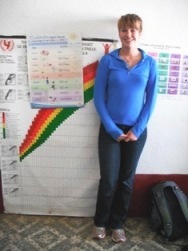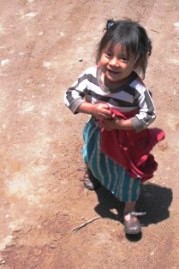 CONWAY, Ark. (Nov. 11, 2009) – Hannah McGrew’s favorite picture from this past summer shows her standing in an urban health center in Guatemala, smiling shyly as she towers over a growth chart posted on the wall behind her. The other posters in the photo have titles like, “When should I bring my child to get vaccinated?” and “How to feed children under 2”.
CONWAY, Ark. (Nov. 11, 2009) – Hannah McGrew’s favorite picture from this past summer shows her standing in an urban health center in Guatemala, smiling shyly as she towers over a growth chart posted on the wall behind her. The other posters in the photo have titles like, “When should I bring my child to get vaccinated?” and “How to feed children under 2”.
McGrew, a sophomore from Albuquerque, N.M., knows how much those posters can mean to parents in a country like Guatemala. Extensive malnutrition means that almost half of Guatemalan children under five suffer from growth stunting and nearly a quarter are underweight. According to the World Health Organization, the problem in Guatemala is not lack of food but rather lack of information.
Leading the charge against malnutrition are innovative local programs such as the one McGrew traveled to Guatemala to study for six weeks. It was established in 2005 by the University of New Mexico-Albuquerque, in partnership with Guatemala’s Universidad de San Carlos, and it focuses on improving children’s health through education. The university doctors trained women from the mountainous rural areas to work as promotoras, or community health workers, in their villages. Educated in the basics of childcare and maternal health, these women serve as the front line in the fight against childhood malnutrition.
McGrew’s task was to find out, four years into the program, whether the promotoras’ training actually had improved the health of the community. Accompanied by a medical student and a promotora, she walked to dozens of houses each day to administer a questionnaire in Spanish and to measure the height and weight of every child younger than five.
“We asked thirty questions about their household and their feeding practices,” McGrew said. “At first they were hesitant to give out personal household information, but the promotora explained it was to help better the community as a whole and to help their children.”
Every evening McGrew and her colleagues commuted for two hours back to their hostel in the city of Quetzaltenango, where they e-mailed their data to a statistician in New Mexico. And every morning they rode back to the rural villages again. Each day, each house, was a new challenge.
 “The questions we asked were sometimes very personal, so it was hard not to seem like we were judging them,” she said. “We would ask, ‘Have you lost a child under five in the last year?’”
“The questions we asked were sometimes very personal, so it was hard not to seem like we were judging them,” she said. “We would ask, ‘Have you lost a child under five in the last year?’”
McGrew remembers the first house she visited where the answer was yes. A fifteen-year-old girl answered the door, holding her baby brother on her hip, and welcomed McGrew into the dilapidated home. She was the sole caretaker for her brother and her blind grandfather, so it was she who answered the questions. Her parents had moved to the city to work after their youngest son died; they needed to make more money, and they left her in charge.
“It was tough, because there were houses that had really benefitted from the program, and then there was this house where it seemed like everything was really so bad for this girl,” McGrew said. “I knew I needed to ask her the questions, that it was for a good reason, to improve the program to help prevent cases like hers. But it was frustrating and saddening for me to have to bring that up with her.”
For the most part, however, the community had noticeably improved. Three children had died in the past year, but the other children in the community were in fairly good health. None were referred to the health center in Quetzaltenango for immediate care.
“Their height-to-weight ratio was good, but they had the wrong height-to-weight-to-age ratio,” McGrew said. “It showed that they were subject to chronic malnourishment, which is an improvement from severe malnourishment.”
McGrew, whose parents are both doctors at the University of New Mexico, hoped to host a follow-up training day for the promotoras. But those plans were canceled after a series of illnesses kept her bedridden in Quetzaltenango and eventually required her to return to the U.S. She contracted the mosquito-transmitted dengue fever, also known as bone-break fever, which left her whole body in “the worst pain of my life”. Shortly after recovering, she contracted amoebic dysentery and was flown back to her home in Albuquerque.
“The experience made me realize how lucky I am to have the healthcare I do and how important it is for these programs to continue to grow,” she said. “The care I received from the Centro de Salud was basic – just an IV and some antibiotics – but it saved my life. These are diseases that can lead to severe malnutrition, and that children die from every day, for lack of very basic medical care.”
Four months after her return to the U.S., she still thinks daily about the lifesaving work she witnessed. Her time in Guatemala convinced her that community health workers are an essential part of healthcare in developing nations, and that healthcare is a universal right. The experience also reaffirmed her decision to design her own major in Medical Anthropology, combining classes from departments such as biology, anthropology and philosophy.
“I’m still trying to put my mind around, what does this project mean to me,” McGrew said. “Because I think it’s going to have some really important implications for how I go about studying and growing up at school.”
McGrew’s project was sponsored and largely funded by the Hendrix Odyssey program, a curricular program that offers funding and credit for experiential learning projects at home and abroad.
“Your Hendrix Odyssey: Engaging in Active Learning” is a major component of the Hendrix curriculum. The philosophy is, “You learn more when you do more.” Each student is required to complete three Odyssey experiences selected from six categories: artistic creativity, global awareness, professional and leadership development, service to the world, undergraduate research, and special projects. McGrew’s project will earn her credit for Special Projects.
Hendrix, founded in 1876, is an undergraduate liberal arts college emphasizing experiential learning in a demanding yet supportive environment. The college is among 371 colleges featured in the 2010 edition of the Princeton Review America’s Best Colleges. Hendrix has been affiliated with the United Methodist Church since 1884. For more information, visit www.hendrix.edu.